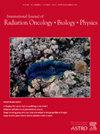Safety Profile of Durvalumab (D) as Consolidation Treatment (tx) in Limited-Stage Small-Cell Lung Cancer (LS-SCLC) in ADRIATIC: Focus on Pneumonitis and Immune-Mediated Adverse Events (imAEs)
IF 6.4
1区 医学
Q1 ONCOLOGY
International Journal of Radiation Oncology Biology Physics
Pub Date : 2024-10-01
DOI:10.1016/j.ijrobp.2024.08.024
引用次数: 0
Abstract
Purpose/Objective(s)
In the phase 3 ADRIATIC study (NCT03703297) in patients (pts) with LS-SCLC without progression after concurrent chemoradiotherapy (cCRT), D as consolidation tx significantly improved OS and PFS vs placebo (P) at the first planned interim analysis. D was well tolerated and AEs were consistent with the known safety profile. Here we present pneumonitis/radiation pneumonitis and imAEs.
Materials/Methods
530 eligible pts with stage I–III LS-SCLC (stage I/II inoperable), WHO PS 0/1, and no progression after cCRT, were randomized 1–42 days after cCRT to D 1500 mg or P every 4 weeks until investigator-determined progression or intolerable toxicity, or for a maximum of 24 months. Safety was a secondary endpoint. Given the similar clinical presentation of pneumonitis resulting from prior RT (radiation pneumonitis) or immunotherapy (immune-mediated pneumonitis), these events were analyzed as a grouped term to better estimate their frequency. imAEs were also assessed.
Results
262 pts received D and 265 received P. Pneumonitis/radiation pneumonitis (preferred terms of immune-mediated lung disease, interstitial lung disease, pneumonitis, radiation fibrosis–lung, and radiation pneumonitis) occurred in 38% (n=100) vs 30% (n=80) of pts in the D vs P arm (maximum grade 3/4 3% vs 3%; grade 5 0.4% vs 0%; leading to tx discontinuation 9% vs 3%). Median time from first study drug dose to onset (mTTO) of pneumonitis/radiation pneumonitis was 56 days (range 1–594) vs 56 days (2–228) in the D vs P arm; 40/100 events in the D arm and 23/80 in the P arm had resolved at data cutoff (Jan 15, 2024). imAEs occurred in 32% vs 10% of pts in the D vs P arm (maximum grade 3/4 5% vs 2%; grade 5 0.4% vs 0%; leading to tx discontinuation 7% vs 3%). 14% vs 6% of pts in the D vs P arms received high-dose steroids and 1% vs 0.4% received immunosuppressants to manage imAEs. The table shows mTTO, resolution, and median time to resolution (mTTR) for the most common imAEs.
Conclusion
In ADRIATIC, pneumonitis/radiation pneumonitis was common in both arms in this population who had received prior RT, and imAEs were as expected in the D arm; these events were mainly low grade and led to low rates of tx discontinuation, supporting the favorable benefit-risk profile for consolidation D after cCRT in LS-SCLC.
ADRIATIC研究中Durvalumab (D)作为限期小细胞肺癌(LS-SCLC)巩固治疗(tx)的安全性概况:聚焦肺炎和免疫相关不良事件(imAEs)
目的/目标在针对LS-SCLC患者的3期ADRIATIC研究(NCT03703297)中,在首次计划的中期分析中,D作为巩固治疗可显著改善OS和PFS,而安慰剂(P)则无进展。D 的耐受性良好,AE 与已知的安全性特征一致。材料/方法530名符合条件的I-III期LS-SCLC(I/II期无法手术)患者,WHO PS 0/1,且cCRT后无进展,在cCRT后1-42天随机接受D 1500 mg或P,每4周一次,直到研究者确定进展或出现不可耐受的毒性,或最长持续24个月。安全性是次要终点。鉴于先前 RT(放射性肺炎)或免疫疗法(免疫介导的肺炎)导致的肺炎具有相似的临床表现,因此将这些事件作为一组术语进行分析,以更好地估计其发生频率。肺炎/放射性肺炎(免疫介导的肺病、间质性肺病、肺炎、放射性肺纤维化和放射性肺炎的首选术语)在 D 组与 P 组中的发生率分别为 38%(n=100)vs 30%(n=80)(最高 3/4 级 3% vs 3%;5 级 0.4% vs 0%;导致停药 9% vs 3%)。肺炎/放射性肺炎从首次服用研究药物到发病(mTTO)的中位时间为 56 天(范围 1-594),而 D 组和 P 组分别为 56 天(2-228);截至数据截止日(2024 年 1 月 15 日),D 组 40/100 例事件和 P 组 23/80 例事件均已缓解。D组与P组相比,14%的患者接受了大剂量类固醇治疗,6%的患者接受了免疫抑制剂治疗,1%的患者接受了免疫抑制剂治疗,0.4%的患者接受了免疫抑制剂治疗。表中显示了最常见imAEs的mTTO、缓解率和中位缓解时间(mTTR)。结论在ADRIATIC中,在既往接受过RT治疗的人群中,肺炎/放射性肺炎在两组中都很常见,D组的imAEs符合预期;这些事件主要是低级别的,导致停药的比例较低,支持LS-SCLC患者在cCRT后巩固D组治疗的有利获益-风险特征。
本文章由计算机程序翻译,如有差异,请以英文原文为准。
求助全文
约1分钟内获得全文
求助全文
来源期刊
CiteScore
11.00
自引率
7.10%
发文量
2538
审稿时长
6.6 weeks
期刊介绍:
International Journal of Radiation Oncology • Biology • Physics (IJROBP), known in the field as the Red Journal, publishes original laboratory and clinical investigations related to radiation oncology, radiation biology, medical physics, and both education and health policy as it relates to the field.
This journal has a particular interest in original contributions of the following types: prospective clinical trials, outcomes research, and large database interrogation. In addition, it seeks reports of high-impact innovations in single or combined modality treatment, tumor sensitization, normal tissue protection (including both precision avoidance and pharmacologic means), brachytherapy, particle irradiation, and cancer imaging. Technical advances related to dosimetry and conformal radiation treatment planning are of interest, as are basic science studies investigating tumor physiology and the molecular biology underlying cancer and normal tissue radiation response.

 求助内容:
求助内容: 应助结果提醒方式:
应助结果提醒方式:


